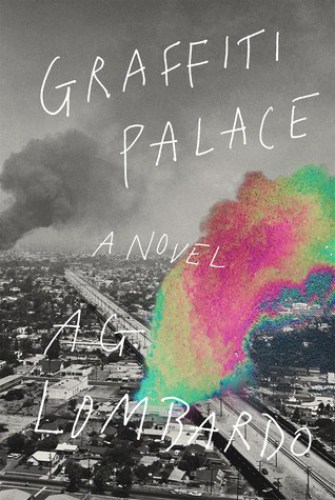
Graffiti Palace
A Novel
کتاب های مرتبط
- اطلاعات
- نقد و بررسی
- دیدگاه کاربران
نقد و بررسی

January 1, 2018
The 1965 Watts riots become the backdrop for one man's journey through a long night of terror, wonder--and semiotic inquiry.Americo Monk sees himself as "kind of an amateur urbanologist," an aficionado of artistic vandalism (aka graffiti), and an underground researcher into the myriad street gangs which declare whole sections of Los Angeles as their armed camp. On the evening of Aug. 11, 1965, when white police make a traffic stop in the streets of predominantly black Watts that sets off a powder keg of pent-up resentments, Monk had been roaming nearby, scribbling random arcana into the notebook that's never left his side. Now he's been swept up in the fiery chaos of the city's worst race riot, far from the home he's made with his pregnant girlfriend, Karmann Ghia, near an abandoned cargo depot along Los Angeles Harbor. So begins Monk's rowdy, near-hallucinatory search for a way back "south, toward the harbor." Throughout Monk's odyssey, he's buffeted and bounced through a series of heart-stopping perils and exotic diversions. Besides the inevitable hassles with LAPD detectives, two of whom covet Monk's notebook for its gang-related info, the people Monk encounters along the way include a phlegmatic "mosquito abatement" officer going about his business in the back alleys, short-tempered Chinese gangsters who've waged bloody all-out war over fortune cookies, a Nation of Islam contingent led by the Honorable Elijah Muhammad himself, and even the notorious Tokyo Rose as she's lugging a bag of jazz LPs to her house. As Monk dodges and weaves his way through the festering, sweltering maelstrom, Karmann, depicted as a kind of Penelope to Monk's Odysseus, tries to keep some kind of order during an unruly rent party. In his debut novel, Lombardo, who flashes impressive stylistic chops throughout, seems to be aiming for his own jazz-inflected version of a Joycean "night town" ramble infused with history, urban legend, dark comedy, and mythological tropes. Sometimes he gets carried away, though. If, for instance, Edward R. Murrow was really doing a CBS newscast on TV three months after he died and four years after he quit the network, then the novel really is a hallucination trumping actual history.Maybe Lombardo's hip-shooting imagery is part of the point he's making: history as a nightmare from which these characters are trying to awake. And nothing in a nightmare is supposed to make sense.
COPYRIGHT(2018) Kirkus Reviews, ALL RIGHTS RESERVED.

January 15, 2018
Lombardo’s auspicious but exhausting debut breathlessly tracks Americo Monk’s tortured journey through Los Angeles during the 1965 Watts Riots. Monk is an overt nod to Odysseus, not a warrior but a scholar of graffiti. He documents the beautiful, portentous runes tagging his burning city, putting down drawings and notes in a blue notebook he nearly gives his life to save. As Monk staggers southward through the mayhem toward his home on the harbor, he encounters, among myriad others, members of a cult of Muslims called the Fruit of Islam, Chinese gangsters at war over fortune cookies, a Japanese woman claiming to be propaganda mouthpiece Tokyo Rose, various voodoo priestesses, brutal cops, and a stranger named Tyrone, “the blind madman with the satellites and ringing phone booths,” likely a stand-in for Homer himself. Monk’s girlfriend, Karmann, waits, like Penelope, among men who want her, her needle that of a record player, marking the time until Monk returns. Everything in this novel is a reference to something else: Media Environmental Displays, USA, a billboard company advertising addictive skin-lightening products, is just one of many clever examples. The language and story are bloated, which softens the impact the novel could’ve had. Nevertheless, Lombardo’s voice is promising, and readers will be intrigued to see what he comes up with next.

February 15, 2018
First-time novelist Lombardo's bravura improvisation on The Odyssey begins in an improvised shipping-container palace on Los Angeles' waterfront, where Karmann Ghia watches her rent party veer out of control while she waits for the return of her lover, Americo Monk. A self-described urbanologist who wanders the city, filling his notebook with the graffiti filigreeing L.A. in an ever-morphing map of gang territories and political protest, Monk is trying to get home, but this is August 1965 and the Watts riots have ignited. As Karmann fends off lecherous suitors, Monk's journey across the siren-shrill, blazing city is repeatedly interrupted by gangsters, cops, temptresses, and seers hoping to seize his precious graffiti Baedeker. Lombardo tosses off Odyssey markers and channels Thomas Pynchon and Colson Whitehead as his hero contends with surreal and dangerous encounters with the Nation of Islam, voodoo practitioners, a one-eyed drug lord, and Godzilla. Despite some forced notes, Lombardo has created an exuberantly cartoonish, incisive, and suspenseful tale of an erupting city and an earnest street scholar intent on making us see the writing on the walls. (Reprinted with permission of Booklist, copyright 2018, American Library Association.)

October 15, 2017
In boiling-over 1965 Los Angeles, graffiti fan Americo Monk is trying to return to the little harbor community built of shipping containers that he and his girlfriend call home. Setting The Odyssey during the 1965 Watts Riots, with surreal overtones, is an awesome idea.
Copyright 2017 Library Journal, LLC Used with permission.

























دیدگاه کاربران